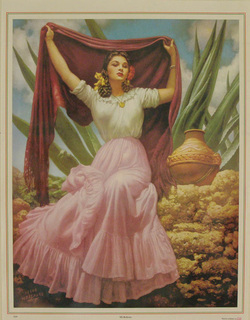The Rebozo
 Few garments evoke the culture of Mexico better than the rebozo. In Maria's Trail, we learn that the rebozo and simple peasant dress was Chica's primary dress long before she became the Beautiful Vaquero.
Few garments evoke the culture of Mexico better than the rebozo. In Maria's Trail, we learn that the rebozo and simple peasant dress was Chica's primary dress long before she became the Beautiful Vaquero. According to Gena Kirby of Progressive Parenting:
"A Rebozo is a traditional Mexican shawl or scarf. For centuries the rebozo has helped women in labor. The rebozo offers support, pain relief and empowerment to the laboring woman, and also to her birth partner. The Rebozo is limitless and can perform many different roles in the lives of women in Mexico and South America.
The rebozo can be an aid in labor, a baby carrier, a knapsack, a cool-weather wrap or elegant shawl. The rebozo is limitless.
Although its origin is Moorish, the Rebozo was introduced into Mexico by the Spanish who demanded that Indigenous women cover their heads in church. The word rebozo is derived from the Spanish word rebozar , meaning to muffle or cover up. Mexican Indigenous women adopted the Rebozo not only for use inside but also outside the church and lavishly decorated them. In his 1794 report to the king, Viceroy Rivillagigedo described rebozos as “an indispensable part of women’s wardrobes”. He wrote that “the women wear them without exception: the nuns and the highest born and richest ladies and the most unfortunate and poorest women of the lowest class.” By the late 19 th century the rebozo had become the symbol of Mexican womanhood, and, like the native woman’s huipil , identified the wearer’s region or village by its color, arrangement of stripes, fabric and fringe type.
The way a woman draped it around her could even indicate her marital status, perhaps availability. Today it is still the most useful garment in Mexico and used in imaginative ways. A rebozo keeps a woman warm and dry and she uses it to carry her baby and even her young child close to her body. It is also used to protect her head from the sun or rain or can be used to haul bundles on the woman’s back. Sometimes it is twisted around the head to balance a water jar. Finally the woman takes it to her grave, wearing it as her shroud." Source ~ Progressive Parenting
Published on August 31, 2012 18:40
No comments have been added yet.



